In the quest for sustainability in new home designs and renovations, understanding the balance between budget and eco-friendly practices is essential. Architect Nicola Dovey, from Drawing Room Architecture, known for her expertise in sustainable architecture, provides valuable insights into how to achieve sustainability across varying budget levels.
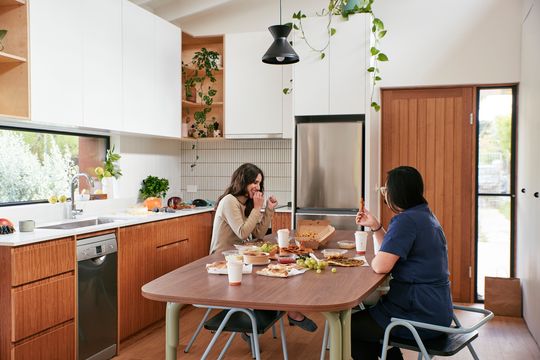
Even with small spaces in challenging sites, applying simple and cost-effective sustainability principles can make a huge difference the your home's performance.
Small Budget Strategies
For projects with a small budget, Nicola emphasises the importance of retaining as much of the existing structure as possible. "If you can keep as much of the existing building as possible, then that's a lot of building you just have to make better," she explains. This approach minimises waste and utilises existing resources efficiently.
Key strategies for small-budget sustainability include:
- Draft Proofing: Ensuring that all gaps and drafts are sealed can significantly reduce energy loss. "Draft proofing, heavy drapes, and insulation can significantly improve a small budget project," says Nicola.
- Insulation: Adding insulation under floors, in ceilings, and within walls can greatly enhance energy efficiency. Simple measures like natural fabric curtains and rugs can help maintain a comfortable indoor climate.
- Shading: External blinds, awnings, and pergola-type shade structures with deciduous vegetation like grape vines can keep heat loading away from internal spaces meaning less mechanical cooling is needed to keep your home comfortable. Smart Retrofitting: Upgrading existing features rather than replacing them can be both cost-effective and environmentally friendly. For instance, using pelmets and heavy drapes for single-glazed windows can improve thermal performance without the need for expensive replacements.
Medium Budget Considerations
With a medium budget, the options for sustainable enhancements increase. Nicola highlights the importance of using materials with more mass, such as brick and masonry, to slow down energy transfer. "Mass slows down energy transfer," she notes, which helps in maintaining stable indoor temperatures.
Additional strategies for medium budgets include:
- Radiant Heating: "Radiant heating, such as in-slab heating or hydronic panels, offers a more comfortable option than purely efficient systems," Nicola explains. This type of heating provides consistent warmth and is energy-efficient.
- Efficient Use of Space: Designing compact yet functional spaces can reduce the overall footprint of the home, leading to lower construction costs and energy use. Built-in furniture and multipurpose rooms are excellent examples of this approach.
- Future-Proofing: Incorporating flexible spaces that can adapt to changing needs over time is a smart investment. Nicola suggests adding multi-use rooms that can serve as home offices, guest rooms, or additional living areas as needed.
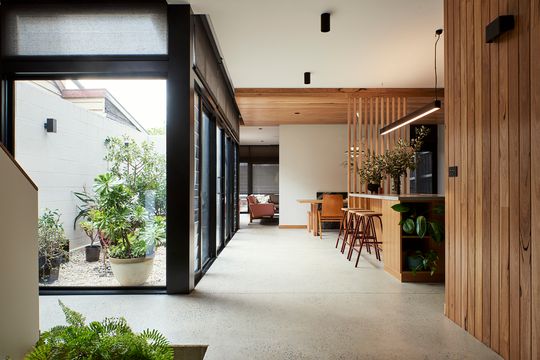
Light wells, thermal mass, and in-slab electric-powered hydronic (radiant) heating, and high levels of insulation keep this home comfortable and efficient year-round.
Large Budget Options
For projects with a generous budget, the focus shifts towards advanced sustainable technologies and high-quality materials. Nicola emphasises the importance of future-proofing and creating self-sustaining energy systems. "Planning for solar panels and batteries helps in creating a self-sustaining energy system," she notes.
Key strategies for large-budget sustainability include:
- High-Quality Materials: Investing in durable, locally-sourced materials can enhance both the aesthetic appeal and the longevity of the home. "For larger budgets, future-proofing becomes key, considering intergenerational living and high-quality, locally-sourced materials," says Nicola.
- Advanced Energy Systems: Implementing all-electric systems, including induction cooktops, hot water heat pumps, and electric hydronic heating, can significantly reduce the home's carbon footprint. Solar panels and energy storage solutions like batteries are essential components of this approach.
- Comprehensive Insulation and Ventilation: Ensuring that the building envelope is both well-insulated, well-oriented and well-ventilated can prevent issues like condensation and mould, which are common in highly insulated homes. "Our walls are performing smarter," Nicola explains, referring to the integration of ventilation cavities that allow for air movement without compromising insulation.
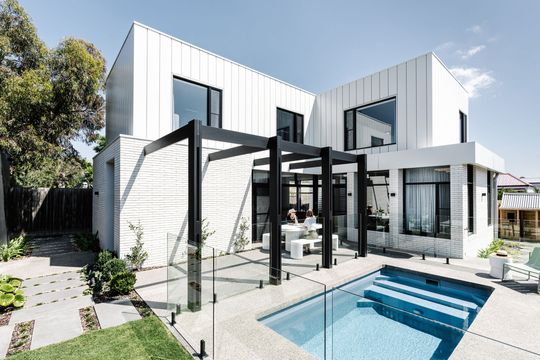
Hope House is like the Tesla Model Y of houses: a mid-sized, all-electric, luxury home. Because it's designed for sustainability and all-electric, the owners can enjoy a bit of luxury without costing the earth.
Passive House vs. High-Performance House
When discussing the concept of a Passive House, Nicola clarifies the distinction between it and a high-performance house. "You can achieve high performance in a house without it being a certified Passive House," she states. The Passive House standard (sometimes referred to as Passivhaus), originating from Germany, focuses on creating an airtight building envelope with controlled ventilation, which is highly effective in cold climates. However, for many parts of Australia, a high-performance house—built with similar principles but not necessarily to Passive House certification—can offer significant benefits. Nicola explains, "It's about making informed decisions based on your specific needs and climate." This approach allows for flexibility in design while still achieving substantial energy savings and comfort.
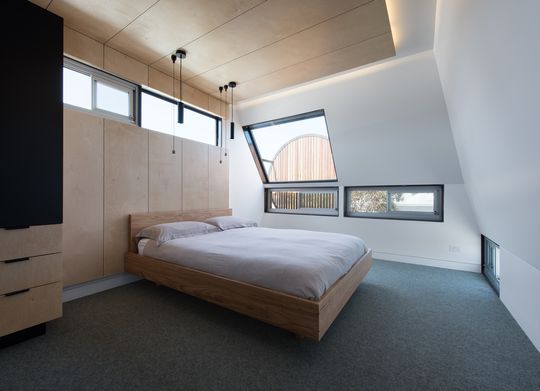
Careful window placement is a key tenant of sustainable design and ensures you're able to capture views, warmth, and prevailing breezes without sacrificing privacy.
Importance of Sunlight
Natural sunlight plays a crucial role in sustainable home design. Proper orientation and window placement can maximise the benefits of daylight, reducing the need for artificial lighting and heating. Nicola elaborates, "Daylight not only warms and lights a room, it animates a room, making it warm, interesting and inviting."
Designing for natural light involves:
- Orientation: Positioning the home to take advantage of the sun's path greatly enhances natural light and warmth. North-facing windows, for example, receive consistent sunlight throughout the day so you want larger windows here. West-facing windows are vulnerable to the hottest rays from the sun so need to be well shaded or kept to a minimum. East-facing windows get the soft and pretty morning light that has little heat in it so still needs consideration to balance heat gains vs losses. South-facing windows will actively let internal heat seep out and will transfer outdoor coolth from southerlies and should be kept to an absolute minimum. The balance of the benefits of southern 'artist’s' light needs to be well considered.
- Window Size and Placement: Large windows in living areas and strategically placed smaller windows in bedrooms can balance light, heat, and privacy. "You want to specifically face rooms and windows in relation to the sun and size windows appropriately," Nicola advises.
- Material mass: It’s also important to be mindful of the heat transfer properties in materials. All materials perform differently when it comes to heat transfer, so you want to select your materials accordingly. For example, metal will move heat energy instantly from one side of the material to the other, whereas bricks, blocks, and rammed earth have a long lag; it takes a considerable amount of time before the heat energy passes from one side of the brick to the other side. A double brick wall will hold a significant amount of heat energy before it moves the heat into the inside of the building. In real terms, a double brick wall can take up to two days of absorbing external heat before it will transfer that heat inside. A dark, metal clad, poorly-insulated wall will transfer heat inside from the moment hot external heat touches the external wall.
- Shading: The best way to keep internal rooms cool in summer, is to keep the heat from getting in in the first place. The best way to do this is operable external awnings, and blinds.
Incorporating elements like courtyards and skylights can further enhance natural light and create a connection with the outdoors, making the home feel more spacious and inviting.
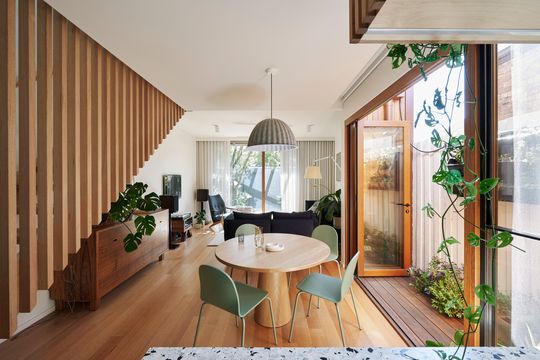
By orienting windows to capture light and using warm, natural materials, Drawing Room Architecture were able to create a much more sustainable home on a very narrow site.
Sustainable home design is achievable across various budget levels, with thoughtful planning and the right strategies. Whether working with a small, medium, or large budget, Nicola Dovey's expertise underscores the importance of retaining existing structures, using materials wisely, and planning for the future. By focusing on energy efficiency, smart use of space, and the benefits of natural sunlight, homeowners can create beautiful, sustainable living environments that are both comfortable and eco-friendly.